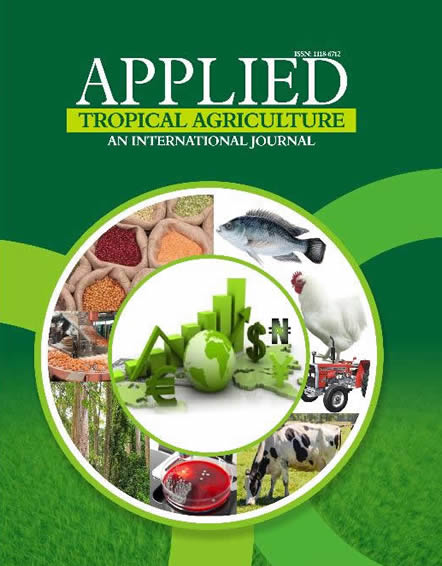PAPER TITLE :COMPOSITION, BIOMASS AND NUTRIENT DISTRIBUTION OF UNDERSTOREY PLANTS IN THREE DIFFERENT PHYSIOGNOMIES IN OBAFEMI AWOLOWO UNIVERSITY ILE-IFE, NIGERIA
APPLIED TROPICAL AGRICULTURE | VOLUME 19 NUMBER 1 2014
Paper Details
- Author(s) : Odiwe, A.I. , Oyakunle, M.O. & Raimi, I.O.
- Abstract:
Understorey species diversity, biomass and their contribution to nutrient distribution were investigated in three forest types within Obafemi Awolowo
University, Ile-Ife, Nigeria. Three plots, 20 m x 20 m (0.4 ha) were established in each of lowland secondary forest, Tectona grandis plantation and riparian
forest vegetation. Five line transects were systematically laid in each plot and a quadrat of 1 m x 1 m placed at every 2 m point to identify and harvest the all
the understorey species. The understorey species were later separated into above and below ground biomass, oven-dried at 70 ºC to a constant weight, weighed,
ground and analyzed for total carbon, nitrogen, phosporus, potassium, calcium, magnesium and sodium. Results showed that the diversity of the understorey
-1 species is highest in the secondary forest. The lowest values for herbs in the aboveground biomass was recorded in the secondary forest (56.5 ± 38.6 Kg ha ) while
-1 the highest was found in the Tectona grandis plantation (144 ± 33.7 Kg ha ). Generally, climbers have significantly higher (p ? 0.05) above ground biomass
than below ground biomass across the three forest sites. The concentration of most elements determined were significantly higher (p < 0.05) in the riparian
vegetation when compared to other sites. This study has shown that understorey species differs in their biomass production and the amount of nutrients returns
into the systems, thus highlights the importance of understorey plants to nutrient availability and management.


